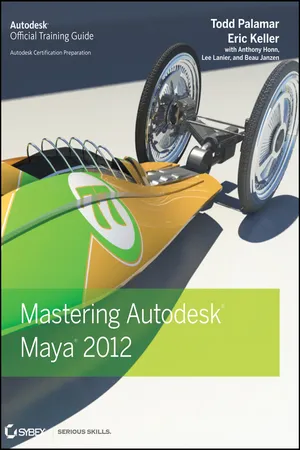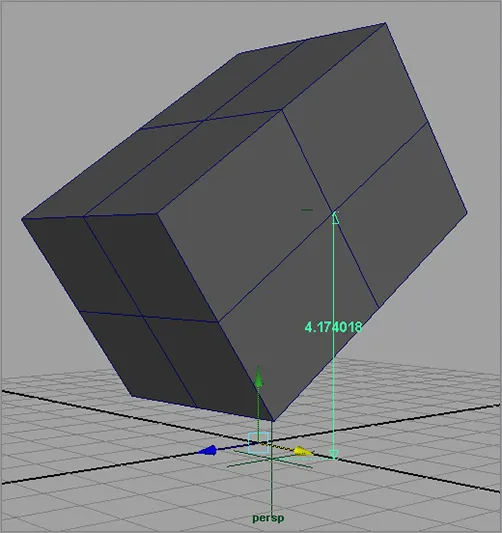
- English
- ePUB (mobile friendly)
- Available on iOS & Android
eBook - ePub
Mastering Autodesk Maya 2012
About this book
The exclusive, official guide to the very latest version of Maya
Get extensive, hands-on, intermediate to advanced coverage of Autodesk Maya 2012, the top-selling 3D software on the market. If you already know Maya basics, this authoritative book takes you to the next level. From modeling, texturing, animation, and visual effects to high-level techniques for film, television, games, and more, this book provides professional-level Maya instruction. With pages of scenarios and examples from some of the leading professionals in the industry, author Todd Palamar will help you master the entire CG production pipeline.
- Provides professional-level instruction on Maya, the industry-leading 3D animation and effects software used in popular films, games, and commercials
- Covers the very latest Maya 2012 tools and features, including the new fluid simulation tools
- Showcases the techniques of professionals through numerous examples, demonstrating how to set up and manage 3D animation and visual effects pipelines
- Includes challenging tutorials and real-world scenarios from some of the leading professionals in the industry
If you're looking for an in-depth, professional Maya resource to turn to again and again, this is the book you need.
Frequently asked questions
Yes, you can cancel anytime from the Subscription tab in your account settings on the Perlego website. Your subscription will stay active until the end of your current billing period. Learn how to cancel your subscription.
At the moment all of our mobile-responsive ePub books are available to download via the app. Most of our PDFs are also available to download and we're working on making the final remaining ones downloadable now. Learn more here.
Perlego offers two plans: Essential and Complete
- Essential is ideal for learners and professionals who enjoy exploring a wide range of subjects. Access the Essential Library with 800,000+ trusted titles and best-sellers across business, personal growth, and the humanities. Includes unlimited reading time and Standard Read Aloud voice.
- Complete: Perfect for advanced learners and researchers needing full, unrestricted access. Unlock 1.4M+ books across hundreds of subjects, including academic and specialized titles. The Complete Plan also includes advanced features like Premium Read Aloud and Research Assistant.
We are an online textbook subscription service, where you can get access to an entire online library for less than the price of a single book per month. With over 1 million books across 1000+ topics, we’ve got you covered! Learn more here.
Look out for the read-aloud symbol on your next book to see if you can listen to it. The read-aloud tool reads text aloud for you, highlighting the text as it is being read. You can pause it, speed it up and slow it down. Learn more here.
Yes! You can use the Perlego app on both iOS or Android devices to read anytime, anywhere — even offline. Perfect for commutes or when you’re on the go.
Please note we cannot support devices running on iOS 13 and Android 7 or earlier. Learn more about using the app.
Please note we cannot support devices running on iOS 13 and Android 7 or earlier. Learn more about using the app.
Yes, you can access Mastering Autodesk Maya 2012 by Todd Palamar,Eric Keller in PDF and/or ePUB format, as well as other popular books in Computer Science & Computer Graphics. We have over one million books available in our catalogue for you to explore.
Information
Chapter 1
Working in Autodesk Maya

Maya’s working environment has evolved to accommodate both the individual artist as well as a team of artists working in a production pipeline. The interface presents tools, controls, and data in an organized fashion to easily allow you to bring your fantastic creations to life. Maya’s interface is made up of four views: the perspective, front, side, and top. Each camera can be customized. Additional cameras can also be created. In each camera view or viewport is a viewing cube located in the upper right corner. The cube allows you to quickly set the current camera to a specific view by clicking on a highlighted area of the cube.
Understanding the way Maya organizes data about the objects, animation, textures, lights, dynamics, and all the other elements contained within the 3D environment of a scene is essential to understanding how the interface is organized. Maya uses what’s known as the Dependency Graph to keep track of the various packets of data, known as nodes, and how they affect each other. Any single element of a Maya scene consists of multiple nodes connected in a web, and each one of these nodes is dependent on another. Maya’s interface consists of editing windows that allow you to connect these nodes in an intuitive way and edit the information contained within each node.
There is usually more than one way to accomplish a task in Maya. As you grow comfortable with the interface, you’ll discover which editing windows best suit your working style.
This chapter is a brief overview of what professionals need to understand when working in Maya. You’ll learn what types of nodes you’ll be working with and how they can be created and edited in Maya. You’ll also learn how to work with projects and scene data as well as the various windows, panels, and controls that make up the interface. This will help you whether you are working alone or as part of a team of artists.
If you’ve never used Maya before, we strongly encourage you to read the Maya documentation as well as Introducing Maya 2012 by Dariush Derakhshani (Sybex, 2011). This chapter is about working with nodes, but it is not meant to be a comprehensive guide to each and every control within Maya. That information is contained within the Maya documentation.
In this chapter, you will learn to:
- Understand transform and shape nodes
- Create a project
- Use assets
- Create file references
Creating and Editing Maya Nodes
A Maya scene is a system of interconnected nodes that are packets of data. The data within a node tells the software about what exists within the world of a Maya scene. The nodes are the building blocks you, as the artist, put together to create the 3D scene and animation that will finally be rendered for the world to see. So if you can think of the objects in your scene, their motion, and appearance as nodes, think of the Maya interface as the tools and controls you use to connect those nodes. The relationship between these nodes is organized by the Dependency Graph, which describes the hierarchical relationship between connected nodes. The interface provides many ways to view the graph, and these methods are described in this chapter.
Any given workflow in Maya is much like a route on a city map. There are usually many ways to get to your destination, and some of them make more sense than others depending on where you’re going. In Maya, the best workflow depends on what you’re trying to achieve, and there is typically more than one possible ideal workflow.
There are many types of nodes in Maya that serve any number of different functions. All the nodes in Maya are considered Dependency Graph (DG) nodes. Let’s say you have a simple cube and you subdivide it once, thus quadrupling the number of faces that make up the cube. The information concerning how the cube has been subdivided is contained within a DG node that is connected to the cube node.
A special type of DG node is the directed acyclic graph (DAG) node. These nodes are made of two specific types of connected nodes: transform and shape. The arrangement of DAG nodes consists of a hierarchy in which the shape node is a child of the transform node. Most of the objects you work with in the Maya viewport, such as surface geometry (cubes, spheres, planes, and so on), are DAG nodes.

To understand the difference between the transform and shape node types, think of a transform node as describing where an object is located and a shape node as describing what an object is. Transform nodes retain translation, rotation, and scale information. Often it is necessary to freeze a node’s transforms. Freezing transformations sets the translation and rotation values to zero and scale values to 1.0 without altering the position of the node. Doing this allows you to add animation and mathematical expressions to zeroed values instead of complex numbers. In addition, freezing the transforms on a node that is a child of another node, forces the child to adopt the transforms of the parent.
The simple polygon cube in Figure 1-1 consists of six flat squares attached at the edges to form a box. Each side of the cube is subdivided twice, creating four polygons per side. That basically describes what the object is, and the description of the object would be contained in the shape node. This simple polygon cube may be 4.174018 centimeters above the grid, rotated 35 degrees on the x-axis, and scaled four times its original size based on the cube’s local x- and y-axes and six times its original size in the cube’s local z-axis. That description would be in the transform node (see Figure 1-1).
Figure 1-1:A shape node describes the shape of an object and how it has been constructed; a transform node describes where the object is located in the scene.

Maya has a number of workspaces that enable you to visualize and work with the nodes and their connections. The following sections describe how these workspaces work together when building a node network in a Maya scene.
Using the Hypergraph
The Hypergraph is a picture of the nodes and their connections in Maya. A complex scene can look like a very intricate web of these connections. When you need to know how a network of nodes is connected, the Hypergraph gives you the most detailed view. There are two ways to view the Hypergraph:
- The hierarchy view shows the relationships between nodes as a tree st...
Table of contents
- Cover
- Title Page
- Credits
- Copyright
- Publisher's Note
- Acknowledgments
- About the Authors
- Introduction
- Chapter 1: Working in Autodesk Maya
- Chapter 2: Virtual Filmmaking with Autodesk Maya Cameras
- Chapter 3: Modeling I
- Chapter 4: Modeling II
- Chapter 5: Animation Techniques
- Chapter 6: Animating with Deformers
- Chapter 7: Rigging and Muscle Systems
- Chapter 8: Paint Effects
- Chapter 9: Lighting with mental ray
- Chapter 10: mental ray Shading Techniques
- Chapter 11: Texture Mapping
- Chapter 12: Rendering for Compositing
- Chapter 13: Introducing nParticles
- Chapter 14: Dynamic Effects
- Chapter 15: Fur, Hair, and Clothing
- Chapter 16: Autodesk Maya Fluids
- Appendix 1
- Appendix 2
- Appendix 3
- Index